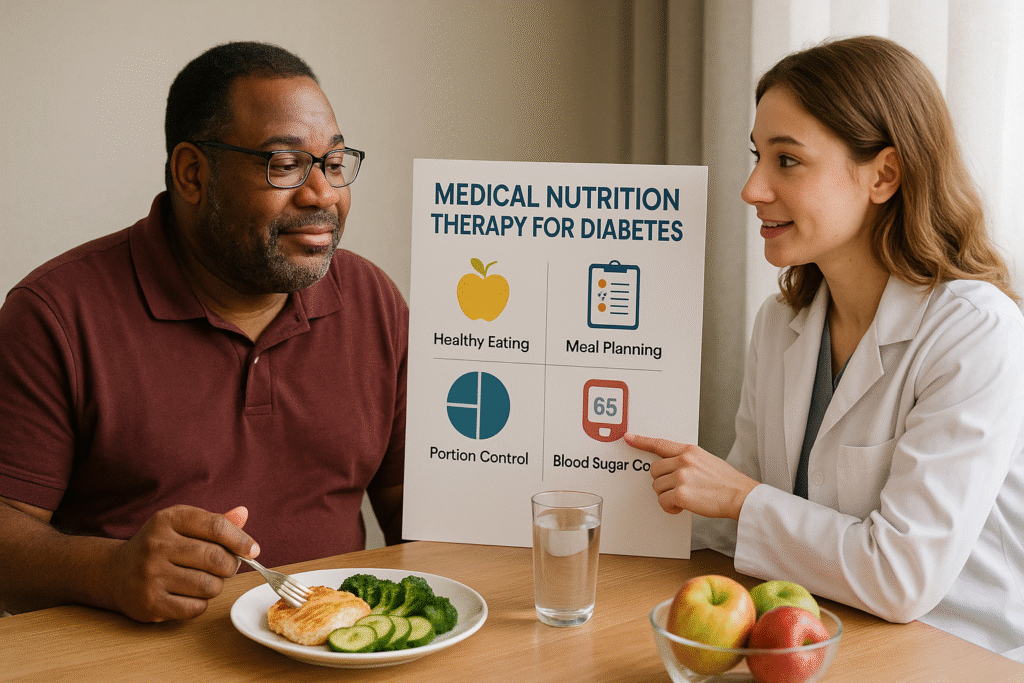Type 2 diabetes affects millions of people worldwide, and its numbers continue to rise each year. While medications and insulin therapy are often part of treatment, research consistently shows that Medical Nutrition Therapy is the cornerstone of diabetes management. The food choices you make every day directly impact blood sugar, body weight, and long-term health outcomes.
This is where Medical Nutrition Therapy (MNT) comes in. More than just a diet, MNT is a personalized plan crafted by a registered dietitian nutritionist (RDN) that adapts to your lifestyle, cultural preferences, and medical needs. Studies show that Medical Nutrition Therapy can reduce A1C by up to 2% in newly diagnosed patients and by about 1% in those with long-standing diabetes. That’s equivalent to the effect of adding a diabetes medication—but without the side effects.
Table of Contents
ToggleWhat Is Medical Nutrition Therapy (MNT)?
Medical Nutrition Therapy is not a one-size-fits-all “diabetic diet.” Instead, it’s a customized nutrition plan designed to:
-
Balance food intake with activity and medications
-
Support weight management
-
Promote heart and kidney health
-
Reduce the risk of diabetes-related complications
-
Allow for flexibility so eating remains enjoyable
Unlike fad diets that cut out entire food groups, Medical Nutrition Therapy focuses on sustainability and balance. The goal isn’t perfection—it’s progress.
Core Goals of Medical Nutrition Therapy in Type 2 Diabetes:
The American Diabetes Association outlines several nutrition goals:
-
Maintain blood sugar near normal through balanced eating.
-
Achieve healthy blood pressure and cholesterol levels to protect the heart.
-
Promote weight management for better insulin sensitivity.
-
Prevent or delay complications such as kidney disease, nerve damage, and cardiovascular disease.
-
Preserve the joy of eating by allowing variety and respecting cultural preferences.
The Role of Weight and Calorie Management in Medical Nutrition Therapy:
For most people with type 2 diabetes, weight plays a huge role in managing blood sugar. Research shows that losing just 5–10% of body weight can:
-
Lower fasting glucose within days of calorie reduction
-
Reduce cholesterol and triglycerides
-
Improve blood pressure
-
Delay or even reverse diabetes progression
Example: A person weighing 200 pounds (90 kg) could see benefits from losing just 10–20 pounds.
Calorie Estimation Guide:
-
Men & active women: ~15 calories per pound
-
Most women, sedentary men, and adults over 55: ~13 calories per pound
-
Sedentary women & adults with obesity: ~10 calories per pound
To lose 1–2 pounds per week, aim for a 500–1000 calorie deficit per day. These principles form the foundation of Medical Nutrition Therapy for sustainable results.
Proven Dietary Approaches:
1. Mediterranean Diet.
-
Includes olive oil, fish, nuts, legumes, fruits, vegetables, and whole grains
-
Shown to improve blood sugar, cholesterol, and reduce heart risks
-
Helps delay the need for diabetes medications
2. Low-Carbohydrate Diets.
-
Reduce post-meal blood sugar spikes
-
May support weight loss in the short term
-
Sustainability can be challenging, especially if combined with insulin
3. Plate Method
-
Half plate: non-starchy vegetables (broccoli, spinach, peppers)
-
Quarter plate: lean protein (chicken, fish, tofu)
-
Quarter plate: healthy carbs (brown rice, sweet potato, beans)
-
A simple yet effective tool within Medical Nutrition Therapy
4. Time-Restricted Eating
-
Limits eating to specific hours, such as 12 PM–8 PM
-
Shown to reduce daily calorie intake and improve A1C in studies
Practical Nutrition Tips for Everyday Living:
-
Stick to consistent carb intake at each meal to prevent spikes.
-
Prioritize high-fiber foods like beans, lentils, and whole grains for steady blood sugar.
-
Swap unhealthy fats: replace butter and red meat with olive oil, nuts, and salmon.
-
Cut out sugary drinks—even fruit juice can cause sharp glucose spikes.
-
Be mindful of alcohol: keep it moderate, and always pair with food.
-
Choose lean proteins such as poultry, fish, legumes, or soy instead of processed meats.
These practical tips are easy ways to put Medical Nutrition Therapy into action daily.
Beyond Food: Lifestyle in Medical Nutrition Therapy
Nutrition is just one part of diabetes care. For best results, combine Medical Nutrition Therapy with:
-
Regular exercise: Aim for 30 minutes of moderate activity most days (walking, cycling, swimming).
-
Blood sugar monitoring: Especially before and after exercise if using insulin.
-
Ongoing support: Work with your healthcare team to adjust your plan as life circumstances change.
FAQs About Medical Nutrition Therapy
1. Is Medical Nutrition Therapy just a strict “diabetic diet”?
No. It’s flexible, personalized, and designed to work with your lifestyle.
2. How fast can I expect results?
Blood sugar can improve within days of calorie reduction, while long-term benefits come with consistent habits.
3. Can Medical Nutrition Therapy actually reverse diabetes?
Yes—significant weight loss (≥15%) has been linked to remission in some patients.
4. Do I need to count carbs every meal?
Not always. Many people do well with simpler tools like the plate method.
5. Should I avoid fats completely?
No. Healthy fats like olive oil, nuts, and avocado are encouraged. The key is to limit saturated and trans fats.
6. Do supplements like cinnamon or chromium work?
Evidence is mixed. They may help slightly, but Medical Nutrition Therapy and lifestyle changes remain the most effective tools.
7.Does Ginger help with T2DM?
Read this article:Benefits of Ginger for Type 2 Diabetes: A Complete Q&A Guide.
Conclusion
Medical Nutrition Therapy is one of the most powerful tools for managing type 2 diabetes. By focusing on balanced nutrition, weight management, and sustainable habits, patients can lower blood sugar, reduce medications, and even achieve remission.
The best part? Medical Nutrition Therapy isn’t about restriction—it’s about creating a lifelong eating pattern that supports health while keeping food enjoyable. If you’re living with type 2 diabetes, consider working with a registered dietitian to build a plan that works for you.
For further reading, check the American Diabetes Association Nutrition Guidelines.
PharmD with expertise in pharmaceuticals and a passion for making medical knowledge clear, accurate and accessible to all








